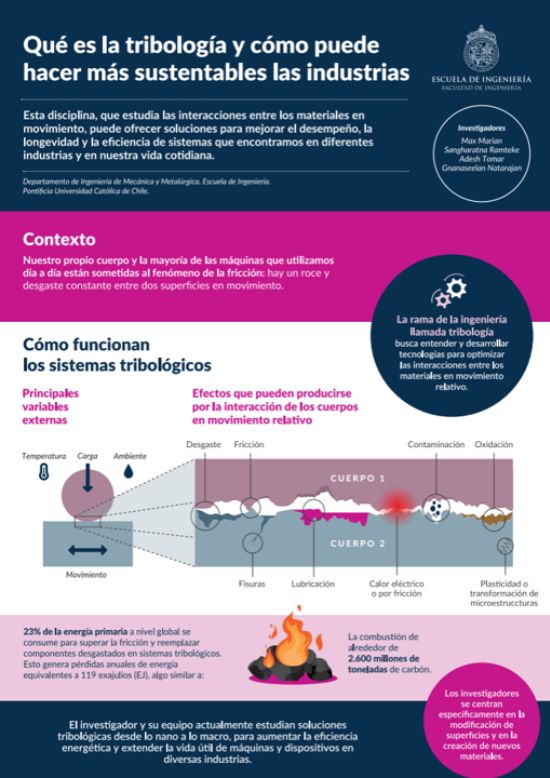Department of Mechanical and Metallurgical Engineering

Portada » Driving Sustainability Through Tribology

Department of Mechanical and Metallurgical Engineering
Have you ever wondered what a human knee, a door hinge, and a wind turbine have in common? They all depend on a little-known but essential science: tribology.
Tribology is the discipline that studies friction, wear, and lubrication between moving surfaces. From the contact of human joints to the operation of complex industrial machinery, this science seeks to understand and optimize those interactions to improve the efficiency and durability of systems.
Although the concept may sound technical, tribology is everywhere. Every time you oil a bicycle chain or apply cream to a sore joint, you’re interacting with a tribological system. These systems are influenced by a wide range of factors working together: the types of materials in contact (such as metal, plastic, or ceramic), the presence or absence of lubricants, and external conditions like temperature, humidity, applied load, or the type of movement between surfaces. Even the microscopic texture of the materials plays a crucial role, as no surface is perfectly smooth. Each of these variables can significantly affect how a tribological system behaves, and understanding them makes it possible to design more durable, efficient, and sustainable solutions.
The diagram shows, on the left, two interacting surfaces influenced by external factors, and on the right, a close-up view of the phenomena that occur at their points of contact.
The impact of tribology across industries
Tribology plays a vital role across a wide range of fields. In industry, for example, it enhances the performance of gears, bearings, and turbines—reducing maintenance and saving operational costs in manufacturing and other fields. In the energy sector, it enables the development of triboelectric nanogenerators, which convert friction—such as the static electricity generated when rubbing a balloon—into power for autonomous devices. In medicine, advances in tribological coatings and materials are key to developing more durable and biocompatible prosthetics and implants, significantly improving the quality of life for thousands of people.
Cutting-edge developments in tribology
As part of their ongoing research in tribology, a team of researchers led by Professor Max Marian is working on the development of advanced materials and engineered surfaces aimed at enhancing the efficiency and durability of mechanical systems in multiple sectors. Their approach integrates two main strategies:
1. Numerical simulations: Using computational models, the team simulates complex systems—such as artificial knees—to predict their behavior and anticipate wear. These simulations allow researchers to design solutions before building physical prototypes.
With tribological numerical methods, it is possible to model and simulate systems like knee joints and predict their behavior in both the short and long term.
2. Experimental methods: To reduce friction and wear, the research team is developing innovative surface modification techniques. Their efforts focus on three cutting-edge approaches that significantly improve the efficiency and longevity of mechanical systems.
Surface micro-texturing: Precise micro-holes are created to serve as lubricant reservoirs, improving distribution and reducing friction.

Diamond-like carbon coatings: Ultra-thin films that merge the exceptional hardness of diamond with the smooth, low-friction qualities of graphite, making them especially suitable for both industrial and medical applications thanks to their excellent biocompatibility.

2D materials: Very thin sheets of materials —just a few atoms thick—like graphene, which have unique properties that help reduce friction and prevent wear, making machines last longer and work more efficiently.

In addition to simulations and experimental approaches, Professor Max Marian’s team has incorporated a cutting-edge tool into their research: artificial intelligence. Specifically, they use a technique known as machine learning, which enables computers to identify patterns and make predictions based on large datasets. What makes their approach unique is that it doesn’t rely solely on data—it also incorporates the physical laws that govern the behavior of materials.
This is known as physics-informed machine learning, and it allows models to not only make more accurate predictions but also ensure those predictions remain physically meaningful. For instance, the team has been able to predict how certain lubricants behave under extreme conditions. These models are especially valuable because they can be applied even when data is scarce, and they offer more reliable results than traditional methods.
By combining physics, data, and algorithms, this team of researchers is opening new possibilities for designing more efficient, durable, and sustainable mechanical systems.
Department of Mechanical and Metallurgical Engineering

Tribology not only optimizes performance—it also contributes to a more sustainable world. Surprisingly, nearly 23% of the world’s primary energy—that which comes directly from natural resources—is lost to friction or the replacement of worn-out components. By reducing these losses, tribology drives an elliptical economy in which products last longer, lowering environmental impact. In the words of professor Max Marian:
Toward a more sustainable economy
“In a country like Chile, which relies heavily on extractive industries such as mining, friction, wear, and lubrication are not just physical phenomena—they are strategic factors. Every component that fails prematurely or every system that runs under suboptimal lubrication conditions represents not only an economic loss but also a gap in efficiency, safety, and sustainability.
This impact goes far beyond mining. In sectors like energy—particularly wind power and seawater-pumped hydro plants, where Chile has enormous potential—the tribological design of components is crucial to ensure durability, reliability, and reduced unplanned maintenance.
Tribology is also making strides in the food industry, enabling the development of more sustainable products by optimizing textures and reducing environmental impact in processing. In biomedical engineering, tribological technologies are key to extending the life and performance of implants and medical devices, directly improving people’s quality of life.
Finally, we must not forget the social dimension: well-applied tribology lowers costs, improves energy efficiency, and promotes a more circular economy. This translates into more accessible and sustainable systems for society as a whole. In that sense, tribology is not only a science of contact—it is also a science of impact.